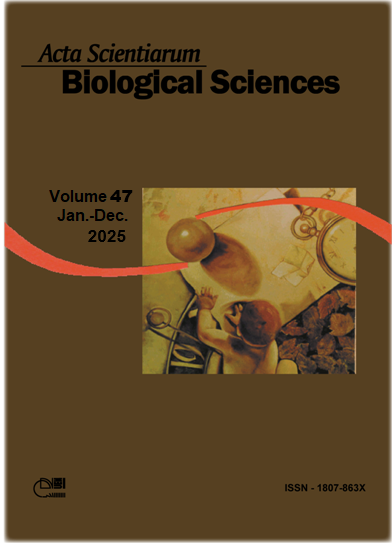Diversity and abundance of planktonic ciliated protists: How the analyzer’s eye can affect the results
Abstract
Planktonic freshwater organisms, such as ciliates, play an important role in the transfer of matter and energy and, therefore, in the functioning of aquatic ecosystems. Due to their small size, the analysis of these communities is usually carried out using optical microscopy and various techniques. However, there are many challenges regarding this group, such as the difficulty in identifying them and the lack of experienced personnel for counting these organisms. Therefore, the aim of this study was to compare possible discrepancies in the results of organism counts, taking into account that these results may be influenced by the individual carrying out the sampling. To this end, the differences in the analyses of richness and abundance performed by four (4) analyzers and their respective ratings of the fixed samples were compared. The hypothesis was that more experienced analyzers would record higher values of species richness and density scores than those with less experience. The results obtained were consistent with the initial hypotheses and showed that two of the more experienced analyzers were associated with higher values for the attributes analyzed.
Downloads
References
Abraham, J. S., Somasundaram, S., Maurya, S., Sood, U., Lal, R., Toteja, R., & Makhija, S. (2024). Insights into freshwater ciliate diversity through high throughput DNA metabarcoding. FEMS Microbes, 5, xtae003. https://doi.org/10.1093/femsmc/xtae003
Altermatt, F., Fronhofer, E. A., Garnier, A., Giometto, A., Hammes, F., Klecka, J., ... Petchey, O. L. (2015). Big answers from small worlds: A user's guide for protist microcosms as a model system in ecology and evolution. Methods in Ecology and Evolution, 6(2), 218–231. https://doi.org/10.1111/2041-210X.12312
Culverhouse, P. F., Williams, R., Reguera, B., Herry, V., & González-Gil, S. (2003). Do experts make mistakes? A comparison of human and machine identification of dinoflagellates. Marine Ecology Progress Series, 247, 17–25. https://doi.org/10.3354/meps247017
DeLong, J. P., & Vasseur, D. A. (2012). Size‐density scaling in protists and the links between consumer–resource interaction parameters. Journal of Animal Ecology, 81(6), 1193–1201. https://doi.org/10.1111/j.1365-2656.2012.02013.x
Elphick, C. S. (2008). How you count counts: The importance of methods research in applied ecology. Journal of Applied Ecology, 45(5), 1313–1320. https://doi.org/10.1111/j.1365-2664.2008.01545.x
Foissner, W. (1991). Basic light and scanning electron microscopic methods for taxonomic studies of ciliated protozoa. European Journal of Protistology, 27(4), 313–330. https://doi.org/10.1016/S0932-4739(11)80248-8
Foissner, W. (1994). Progress in taxonomy of planktonic freshwater ciliates. Marine Microbial Food Webs, 8(1-2), 9–35.
Freibott, A., Linacre, L., Landry, & Michael R. (2014). A slide preparation technique for light microscopy analysis of ciliates preserved in acid Lugol's fixative. Limnology and Oceanography: Methods, 12(1), 54–62. https://doi.org/10.4319/lom.2014.12.54
Grattepanche, J. D., Santoferrara, L. F., Andrade, J., Oliverio, A. M., McManus, G. B., & Katz, L. A. (2014). Distribution and diversity of oligotrich and choreotrich ciliates assessed by morphology and DGGE in temperate coastal waters. Aquatic Microbial Ecology, 71(3), 211–221. https://doi.org/10.3354/ame01675
Kotyk, M., Bourland, W. A., Soviš, M., Méndez-Sánchez, D., Škaloud, P., Kotyková Varadínová, Z., & Čepička, I. (2023). Morphology matters: Congruence of morphology and phylogeny in the integrative taxonomy of Clevelandellidae (Ciliophora: Armophorea) with description of six new species. Zoological Journal of the Linnean Society, zlad154. https://doi.org/10.1093/zoolinnean/zlad154
Li, T., Liu, M., Zhang, J., Al-Rasheid, K. A., Chen, Z., Song, W., & Wang, Z. (2024). Diversity in freshwater scuticociliates (Alveolata, Ciliophora, Scuticociliatia): Two new species isolated from a wetland in northern China, focusing on their morphology, taxonomy, and molecular phylogeny, with establishment of a new family Glauconematidae fam. nov. Water Biology and Security, 100275. https://doi.org/10.1016/j.watbs.2024.100275
Lindström, E. S., Weisse, T., & Stadler, P. (2002). Enumeration of small ciliates in culture by flow cytometry and nucleic acid staining. Journal of Microbiological Methods, 49(2), 173–182. https://doi.org/10.1016/S0167-7012(01)00366-9
Liu, W., Zhang, K., Chen, C., Li, J., Tan, Y., Warren, A., & Song, W. (2019). Overview of the biodiversity and geographic distribution of aloricate oligotrich ciliates (Protozoa, Ciliophora, Spirotrichea) in coastal waters of southern China. Systematics and Biodiversity, 17(8), 787–800. https://doi.org/10.1080/14772000.2019.1691081
Oliveira, F. R., Lansac-Tôha, F. M., Meira, B. R., Progênio, M., & Velho, L. F. M. (2024). Influence of ecological multiparameters on facets of β-diversity of freshwater plankton ciliates. Microbial Ecology, 87(1), 10. https://doi.org/10.1007/s00248-023-02312-9
Pfister, G., Sonntag, B., & Posch, T. (1999). Comparison of a direct live count and an improved quantitative protargol stain (QPS) in determining abundance and cell volumes of pelagic freshwater protozoa. Aquatic Microbial Ecology, 18(1), 95–103. https://doi.org/10.3354/ame018095
Progênio, M., Rosa, J., Oliveira, F. R., Meira, B. R., Santana, L. O., & Machado Velho, L. F. (2024). Dormant ciliate community from the dry sediment of a temporary lake in a Neotropical floodplain. Tropical Ecology, 1–10. https://doi.org/10.1007/s42965-024-00349-6
Regali-Seleghim, M. H., Godinho, M. J. L., & Matsumura-Tundisi, T. (2011). Checklist dos ‘protozoários’ de água doce do Estado de São Paulo, Brasil. Biota Neotropica, 11, 389–426. https://doi.org/10.1590/S1676-06032011000500014
Schwarz, M. J., & Frenzel, P. (2003). Population dynamics and ecology of ciliates (Protozoa, Ciliophora) in an anoxic rice field soil. Biology and Fertility of Soils, 38, 245–252. https://doi.org/10.1007/s00374-003-0644-z
Weisse, T., & Montagnes, D. J. S. (2022). Ecology of planktonic ciliates in a changing world: Concepts, methods, and challenges. Journal of Eukaryotic Microbiology, 69(5), e12879. https://doi.org/10.1111/jeu.12879
Copyright (c) 2025 Matheus Henrique de Olivieira de Matos, João Vitor Bredariol, Gabriel Arthur Lopes da Silva, Loiani Oliveira Santana, Carolina Leite Guimarães Durán, Luiz Felipe Machado Velho (Autor)

This work is licensed under a Creative Commons Attribution 4.0 International License.
DECLARATION OF ORIGINALITY AND COPYRIGHTS
I Declare that current article is original and has not been submitted for publication, in part or in whole, to any other national or international journal.
The copyrights belong exclusively to the authors. Published content is licensed under Creative Commons Attribution 4.0 (CC BY 4.0) guidelines, which allows sharing (copy and distribution of the material in any medium or format) and adaptation (remix, transform, and build upon the material) for any purpose, even commercially, under the terms of attribution.
Read this link for further information on how to use CC BY 4.0 properly.












1.png)




3.png)













